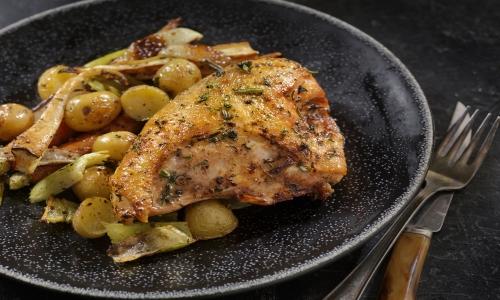
Ingredients for 4 servings:
- 4 chicken breast fillets (approx. 175 g each)
- 800 g potatoes
- Salt, pepper
- 4 medium-sized onions
- 40 g clarified butter
- 1-2 garlic cloves
- 2 tbsp liquid honey
- 2 heaped tbsp sliced almonds
- 1 bunch of rosemary
- 1 jar (400 ml) chicken broth
- 3-4 gelatine sheets or 6 g powdered gelatine (please follow manufacturer's instructions)
- 100 ml white wine
Preparation:
- Wash and pat chicken breast fillets and potatoes dry. Season chicken on all sides with salt and pepper. Cut potatoes in quarters. For the moment, also season with salt and pepper.
- Peel onions, cut into small pieces and distribute across the dripping pan of the oven. Place fillets and potatoes on a rack and slide into the oven over the dripping pan.
- Drizzle with hot clarified butter and cook in a preheated oven (electric cooker: 175°C/ gas: level 2) for approx. 30 minutes. In the meantime, peel garlic cloves and squeeze them through a garlic press. Mix with honey and sliced almonds. Remove rosemary leaves from stems.
- After 30 minutes, pour broth over chicken breast fillets, turn them over and drizzle with honey mixture. Also turn the potatoes over and sprinkle with rosemary leaves. Cook for approx. 3-5 minutes at 220°C/ gas: level 4 until done.
- For the gravy, soak gelatine in cold water. Pour drippings into a pot. Add white wine, bringing it briefly to a boil. Season well with salt and pepper. Squeeze out gelatine and stir into the gravy. Let thicken slightly, drizzle over individual portions of chicken and serve.
Goes well with a cold beer.
Click here for more information on cooking and baking with gelatine.
Nutritional values per person approx.:
- Calories: 366
- Joules: 1535
- Protein: 35.3 g
- Fat: 5.4 g
- Carbohydrates: 38.2 g
Some facts about the potato
Especially during the winter months, hearty dishes are often popular menu choices. The potato is considered an ideal side for cabbage or meat dishes. However, placing the popular tuber into the category of a mere “satiating side dish” would be doing it a grave injustice.
After all, the potato is one of the most versatile foods in our kitchen and the fourth most important basic foodstuff following rice, corn and wheat. Over 5,000 different varieties can be found worldwide, one for almost every purpose and for the most varying of climatic conditions. With 69 million tons a year, China is the foremost cultivator of the crop – although the majority of these potatoes are still being grown for export as the potato is only slowly making headway on the Asian market. In terms of consumption, eastern European countries have taken the lead with up to 250 kg a year. The least amount is consumed in South America and Africa – which is particularly interesting since the Spanish conquistadors initially brought the potato over to Europe from the Andes. In Europe, the potato first got established in German cuisine in the mid-18th century, and then spread over to other European countries from there.
Today, the potato is such an integral part of our cuisine that it is hard to imagine life without it, from its use in the industrial manufacture of such products as the crisp, to the central role it plays in the fast-food sector in the form of French fries, and finally to all the many different variants served in restaurants and regional cuisine. The proper variety is chosen based on what the potato is intended for: waxy potatoes are perfect for potato salads and for boiling either with the skin or without. Medium, or “all-purpose”, varieties are best used for casseroles or soups, while starchy potatoes are ideal for mashed potatoes, dumplings or German Reibekuchen (grated and fried raw potatoes).
When it comes to storage, however, things become a little tricky: too much light makes them quickly turn green, too high temperatures make them start to sprout. Ideally, potatoes should be stored in a cool and dark place, such as a basement, larder, or the vegetable cooler of a refrigerator. To avoid moisture build up, potatoes should not be kept in plastic bags and instead stored in baskets, paper bags, cloth bags or crates.
If this is kept in mind, they will easily keep for many weeks during the winter – right up to the end of May when the first early potatoes are ready for harvest.